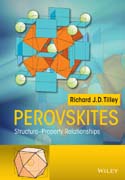
Uniquely describes both the crystallography and properties of perovskite related materials. Practical applications in solar cells, microelectronics and telecommunications Interdisciplinary topic drawing on materials science, chemistry, physics, and geology Contains problems and answers to enhance knowledge retention INDICE: CHAPTER 1 THE ABX3 PEROVSKITE STRUCTURE .1.1 Perovskites .1.2 The cubic perovskite structure: SrTiO3 .1.3 The Goldschmidt tolerance factor .1.4 ABX3 perovskite structure variants .1.5 Cation displacement: BaTiO3 as an example .1.6 Jahn–Teller octahedral distortion: KCuF3 as an example .1.7 Octahedral tilting .1.7.1 Tilt descriptions .1.7.2 Trigonal symmetry: LaAlO3 as an example .1.7.3 Orthorhombic symmetry: GdFeO3 and CaTiO3 as examples .1.8 Symmetry relationships .1.9 Hybrid organic–inorganic perovskites .1.10 Antiperovskites .1.10.1 Cubic and related structures .1.10.2 Other structures .1.11 Structure–field maps .1.12 Theoretical calculations .Further Reading .CHAPTER 2 ABX3–RELATED STRUCTURES .2.1 Double perovskites and related ordered structures .2.1.1 Rock salt ordered double perovskites .2.1.2 Other ordered perovskites .2.1.3 AA 3B4O12–related phases .2.2 Anion substituted perovskites .2.2.1 Nitrides and oxynitrides .2.2.2 Oxyfluorides .2.3 A–site deficient perovskite structures .2.3.1 ReO3, WO3 and related structures .2.3.2 Perovskite tungsten bronzes .2.3.3 A–site deficient titanates, niobates and tantalates .2.4 Anion deficient phases containing tetrahedra .2.4.1 Brownmillerites .2.4.2 Brownmillerite microstructures .2.4.3 Temperature variation and disorder .2.4.4 B–site doped brownmillerite phases .2.4.5 B–site doping and oxygen pressure .2.4.6 A–site doped brownmillerite phases .2.4.7 Brownmillerite related phases .2.5 Anion deficient phases containing square pyramids .2.5.1 Manganites .2.5.2 SrFeO2.5 and related phases .2.6 Point defects, microdomains and modulated phases .Further Reading .CHAPTER 3 HEXAGONAL PEROVSKITE–RELATED STRUCTURES .3.1 The BaNiO3 structure .3.2 BaNiO3–related phases containing trigonal prisms .3.2.1 Commensurate structures .3.2.2 Modulated structures .3.3 Perovskites with mixed hexagonal/cubic packing: nomenclature .3.4 Perovskites with mixed hexagonal/cubic packing: stacking sequences .3.5 Hexagonal perovskites with chq and cph stacking .3.5.1 (chq) structures .3.5.2 (cph) structures .3.5.3 Intergrowth structures .3.6 Hexagonal perovskites with cphh stacking .3.6.1 (cc chh) AnBnO3n structures .3.6.2 (cc chh) AnBn–1O3n structures .3.6.3 Intergrowth structures .3.6.4 AnBn–1O3n shift and twinned structures .3.7 Anion deficient phases containing BaO2 (c ) layers .3.7.1 ( c c ch) structures .3.7.2 (c c chh) structures .3.7.3 (c c chhh) structures .3.8 Anion deficient phases with BaOX layers .3.8.1 (h ) structures .3.8.2 (c c ) structures .3.9 Sr4Mn3O10 and Ba6Mn5O16 .3.10 Temperature and pressure variation .Further Reading .CHAPTER 4 MODULAR STRUCTURES .4.1 K2NiF4 and Ruddleston–Popper related phases .4.1.1 The K2NiF4 (T or T/O) structure .4.1.2 Ruddleston–Popper phases .4.2 The Nd2CuO4 (T ) and T? structures .4.3 Dion–Jacobson and related phases .4.4 Aurivillius phases .4.5 The Ca2Nb2O7 related phases .4.6 Cuprate superconductors and related phases .4.6.1 La2CuO4, Nd2CuO4 and YBa2Cu3O7 .4.6.2 Layered perovskite structures .4.6.3 Structures related to the layered cuprate phases .4.7 Composition variation .4.8 Intercalation and exfoliation .Further Reading .CHAPTER 5 DIFFUSION AND IONIC CONDUCTIVITY .5.1 Diffusion .5.2 Ionic conductivity .5.3 Proton conductivity .5.4 Oxygen pressure dependence and electronic conductivity .5.5 Oxide ion mixed conductors .5.6 Proton mixed conductors .5.7 Solid oxide fuel cells (SOFC) .Further Reading .CHAPTER 6 DIELECTRIC PROPERTIES .6.1 Insulating perovskites .6.2 Dielectric perovskites .6.2.1 General properties .6.2.2 Colossal dielectric constant materials .6.3 Ferroelectric/piezoelectric perovskites .6.3.1 Spontaneous polarization and domains .6.3.2 Ferroelectric domain switching .6.3.3 Ferroelectric hysteresis loops .6.3.4 Temperature dependence of ferroelectricity .6.3.5 Pyroelectrics, piezoelectrics and crystal symmetry .6.3.6 Strain versus electric field loops .6.4 The development of ferroelectric/piezoelectric ceramic bodies .6.4.1 Ceramic piezoelectrics .6.4.2 Electrostriction .6.5 Antiferroelectrics .6.6 Ferrielectrics .6.7 Relaxor ferroelectrics .6.7.1 Macroscopic characteristics of relaxor ferroelectrics .6.7.2 Microstructures of relaxor ferroelectrics .6.8 Hybrid Ferroelectricity .6.9 Doping and modification of properties .6.10 Nanoparticles and thin films .Further Reading .CHAPTER 7 MAGNETIC PROPERTIES .7.1 Magnetism in perovskites .7.2 Paramagnetic perovskites .7.3 Antiferromagnetic perovskites .7.3.1 Cubic related structures .7.3.2 Hexagonal perovskites .7.4 Ferromagnetic perovskites .7.5 Ferrimagnetic perovskites .7.6 Spin glass behaviour .7.7 Canted spins and other magnetic ordering .7.8 Thin films .7.9 Nanoparticles .7.10 Multiferroic perovskites and the magnetoelectric effect .Further Reading .CHAPTER 8 ELECTRONIC CONDUCTIVITY .8.1 Perovskite band structure: metallic perovskites .8.2 Metal–insulator transitions .8.2.1 Titanates and related phases .8.2.2 LnNiO3 .8.2.3 Lanthanoid manganites 8.2.4 Lanthanoid cobaltites .8.2.5 (Sr, Ca)2RuO4 and Ca2Ru1–xCrxO4 .8.2.6 NaOsO3 .8.3 Perovskite superconductors .8.4 Cuprate high temperature superconductors .8.4.1 Overview .8.4.2 Lanthanum cuprate, La2CuO4 .8.4.3 Neodymium cuprate, Nd2CuO4 .8.4.4 Yttrium barium copper oxide, YBa2Cu3O7 .8.4.5 Perovskite–related structures and series .8.4.6 The generic superconductivity phase diagram .8.4.7 Defects and conductivity .8.5 Spin polarization and half metals .8.6 Charge ordering and orbital ordering .8.7 Magnetoresistance .8.7.1 Colossal magnetoresistance in manganites .8.7.2 Low field magnetoresistance .8.8 Semiconductivity in perovskites .8.9 Thin films and surface conductivity .Further Reading .CHAPTER 9 THERMAL AND OPTICAL PROPERTIES .9.1 Thermal expansion .9.1.1 Normal thermal expansion .9.1.2 Thermal contraction .9.1.3 Zero thermal contraction materials .9.2 Thermoelectric properties .9.3 The Magnetocaloric effect .9.4 The Pyroelectric and Electrocaloric effect .9.5 Transparency .9.6 Electrochromic films .9.7 Electro–optic properties .9.7.1 Refractive index changes .9.7.2 Electro–optic phase modulators .9.7.3 Electro–optic intensity modulators .9.7.4 Ceramic modulators .9.8 Perovskite solar cells .Further Reading .Appendix 1 The bond valence model for perovskites .Appendix 2 Summary of the Kroger–Vink defect notation
- ISBN: 978-1-118-93566-8
- Editorial: Wiley–Blackwell
- Encuadernacion: Cartoné
- Páginas: 400
- Fecha Publicación: 13/05/2016
- Nº Volúmenes: 1
- Idioma: Inglés
